Summer Hazards: Blossoms, Blooms & Berries
In summertime, flowers and shrubs put forth a lovely (and sometimes tantalizing) array of blossoms and berries. Homeowners need to exercise care to ensure that guests, invitees, and others don’t suffer injury as a result of attractive landscape features and plants.
BEWARE OF PLANTING TOXIC SPECIES
Many ornamental plants are toxic if ingested, and this doesn’t apply only to berries and other fruits.
Many plants, like oleander, produce poisonous oils in their stems, leaves, and flowers, and the plant doesn’t have to be eaten to cause a problem. Oleander oils on the skin can be accidentally ingested by transfer to finger foods or when children (or adults) place hands or fingers in their mouths.
Homeowners should research all species before landscaping or planting trees and shrubs. When possible, avoid the toxic species, especially if the home is frequented (or inhabited) by young children and pets–the groups most at risk for accidental poisonings and ingestion of plants and other non-food items.
If you cannot remove toxic species, or choose to plant them, be aware of the risks and do your best to mitigate them through conscious actions. Gather up toxic blooms or berries as soon as they fall–or pick them off bushes before that if possible. Never allow small children or pets to play around toxic plants or trees, and supervise them closely when in the yard.
FERTILIZERS AND BUG SPRAYS MAY TURN HARMLESS PLANTS INTO TOXIC ONES
Many homeowners overlook the danger of toxic residues from fertilizers, insect sprays, and other garden poisons. Ant, snail, and rat baits are particularly dangerous, because the formulas are designed to lure these pests to eat them.
Even when poisons are not deliberately scattered, residue from fertilizers, runoff, and other toxins can dry on leaves and flowers, rendering them poisonous.
When possible, choose non-toxic fertilizers and natural forms of pest control (for example, planting society garlic and chives near roses to ward off aphids, or purchasing ladybugs and other natural pest-eaters). Rinse plants and walkways after use of toxic chemicals whenever you can, especially if the toxin is designed for rapid absorption or effect.
Most importantly, keep toxins and fertilizers in secure locations, well away from small children, pets, and others who might misuse or ingest them. Never assume that children (or pets) will ignore or be unable to open fertilizers, poisons, or other containers. Many tragedies started with “I didn’t think she’d go after it…”
TAKE CARE TO KEEP YOUR YARD SAFE THROUGH THE SUMMER
Regular maintenance and awareness can avoid many summer accidents, particularly where poisonous plants and other toxins are concerned. Prune or remove toxic species, and supervise children and pets to prevent them from accidentally ingesting poisonous plants. Use fertilizers and bug sprays rarely (if at all) and keep them safely locked away when not in use.
Nothing can guarantee a lack of accidents in and around the home, but vigilance, careful planning, and proper maintenance can help homeowners lessen the risk of accidental injury, and even death.















